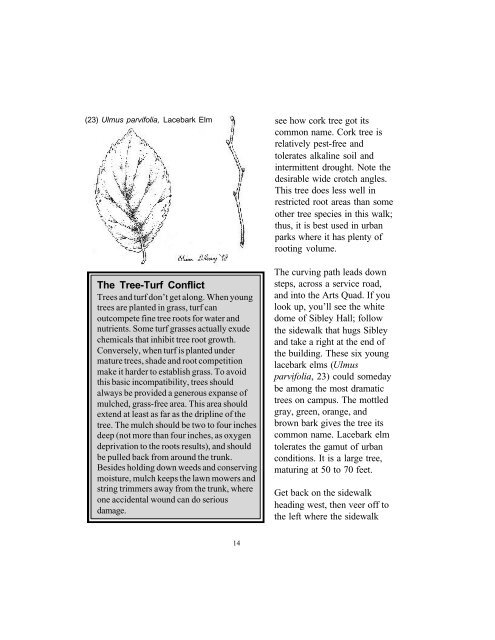Recommended Urban Trees: A Cornell Campus Walk - Horticulture ...
Recommended Urban Trees: A Cornell Campus Walk - Horticulture ...
Recommended Urban Trees: A Cornell Campus Walk - Horticulture ...
Create successful ePaper yourself
Turn your PDF publications into a flip-book with our unique Google optimized e-Paper software.
(23) Ulmus parvifolia, Lacebark Elm<br />
The Tree-Turf Conflict<br />
<strong>Trees</strong> and turf don’t get along. When young<br />
trees are planted in grass, turf can<br />
outcompete fine tree roots for water and<br />
nutrients. Some turf grasses actually exude<br />
chemicals that inhibit tree root growth.<br />
Conversely, when turf is planted under<br />
mature trees, shade and root competition<br />
make it harder to establish grass. To avoid<br />
this basic incompatibility, trees should<br />
always be provided a generous expanse of<br />
mulched, grass-free area. This area should<br />
extend at least as far as the dripline of the<br />
tree. The mulch should be two to four inches<br />
deep (not more than four inches, as oxygen<br />
deprivation to the roots results), and should<br />
be pulled back from around the trunk.<br />
Besides holding down weeds and conserving<br />
moisture, mulch keeps the lawn mowers and<br />
string trimmers away from the trunk, where<br />
one accidental wound can do serious<br />
damage.<br />
14<br />
see how cork tree got its<br />
common name. Cork tree is<br />
relatively pest-free and<br />
tolerates alkaline soil and<br />
intermittent drought. Note the<br />
desirable wide crotch angles.<br />
This tree does less well in<br />
restricted root areas than some<br />
other tree species in this walk;<br />
thus, it is best used in urban<br />
parks where it has plenty of<br />
rooting volume.<br />
The curving path leads down<br />
steps, across a service road,<br />
and into the Arts Quad. If you<br />
look up, you’ll see the white<br />
dome of Sibley Hall; follow<br />
the sidewalk that hugs Sibley<br />
and take a right at the end of<br />
the building. These six young<br />
lacebark elms (Ulmus<br />
parvifolia, 23) could someday<br />
be among the most dramatic<br />
trees on campus. The mottled<br />
gray, green, orange, and<br />
brown bark gives the tree its<br />
common name. Lacebark elm<br />
tolerates the gamut of urban<br />
conditions. It is a large tree,<br />
maturing at 50 to 70 feet.<br />
Get back on the sidewalk<br />
heading west, then veer off to<br />
the left where the sidewalk

















